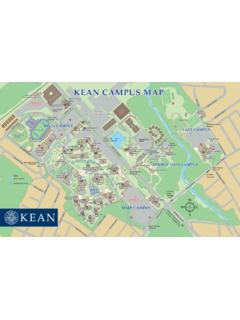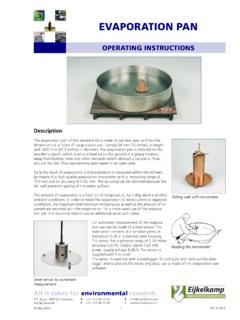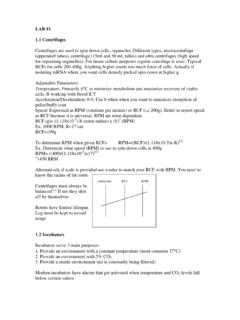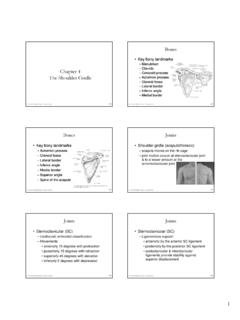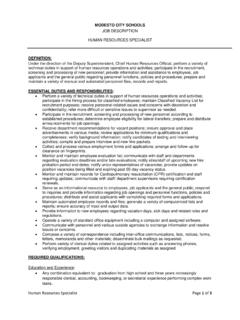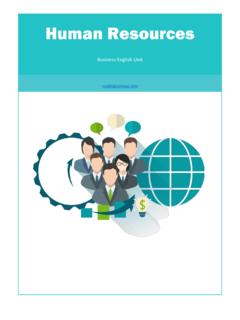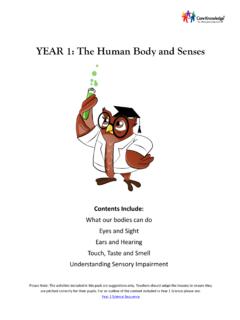Transcription of The Human Side of Enterprise - Kean University
1 6 Volume 2, Number 1, REFLECTIONSThe Human Sid eof Ent erpriseDouglas McGregorCLASSIC 1966 by the Massachusetts Institute ofTechnology. From Leadership and Motiva-tion, Essays of Douglas McGregor, edited byW. G. Bennis and E. H. Schein (Cambridge,MA: MIT Press, 1966): 3 20. Reprintedwith has become trite to say that the most significant developments of the nextquarter century will take place not in the physical but in the social sciences,that industry the economic organ of society has the fundamental know-howto utilize physical science and technology for the material benefit of mankind,and that we must now learn how to utilize the social sciences to make ourhuman organizations truly people agree in principle with such statements; but so far they rep-resent a pious hope and little else. Consider with me, if you will, somethingof what may be involved when we attempt to transform the hope into me begin with an analogy. A quarter century ago basic conceptions of thenature of matter and energy had changed profoundly from what they had beensince Newton s time.
2 The physical scientists were persuaded that under properconditions new and hitherto unimagined sources of energy could be madeavailable to know what has happened since then. First came the bomb. Then, dur-ing the past decade, have come many other attempts to exploit these scientificdiscoveries some successful, some point of my analogy, however, is that the application of theory in thi sfield is a slow and costly matter. We expect it always to be thus. No one isimpatient with the scientist because he cannot tell industry how to build asimple, cheap, all-purpose source of atomic energy today. That it will take atleast another decade and the investment of billions of dollars to achieve re-sults which are economically competitive with present sources of power is un -derstood and is transparently pretentious to suggest any direct similarity between th edevelopments in the physical sciences leading to the harnessing of atomic en-ergy and potential developments in the social sciences.
3 Nevertheless, the anal-ogy is not as absurd as it might appear to be at first a lesser degree, and in a much more tentative fashion, we are in a po-sition in the social sciences today like that of the physical sciences with re-spect to atomic energy in the thirties. We know that past conceptions of thenature of man are inadequate and in many ways incorrect. We are becomingquite certain that, under proper conditions, unimagined resources of creativehuman energy could become available within the organizational cannot tell industrial management how to apply this new knowledgein simple, economic ways. We know it will require years of exploration, muchcostly development research, and a substantial amount of creative imaginationon the part of management to discover how to apply this growing knowledgeto the organization of Human effort in published in Adventure in Thoughtand Action, Proceedings of the Fifth Anni-versary Convocation of the School of In -dustrial Management, Massachusetts Insti-tute of Technology, Cambridge, April 9,1957.
4 Cambridge, MA: MIT School of In -dustrial Management, 1957; and re-printed in The Management Review, 1957,46, No. 11, 22 28 .7 The Human side of Enterprise McGREGORREFLECTIONS, Volume 2, Number 1 May I ask that you keep this analogy in mind overdrawn and pretentiousthough it may be as a framework for what I have to say this s Task: Conventional ViewThe conventional conception of management s task in harnessing Human en-ergy to organizational requirements can be stated broadly in terms of threepropositions. In order to avoid the complications introduced by a label, I shallcall this set of propositions Theory X is responsible for organizing the elements of productive en -terprise money, materials, equipment, people in the interest of eco-nomic respect to people, this is a process of directing their efforts, motivat-ing them, controlling their actions, modifying their behavior to fit th eneeds of the this active intervention by management, people would be pas-sive even resistant to organizational needs.
5 They must therefore be per-suaded, rewarded, punished, controlled their activities must be is management s task in managing subordinate managers or work-ers. We often sum it up by saying that management consists of gettingthings done through other this conventional theory there are several additional beliefs less ex -plicit, but average man is by nature indolent he works as little as lacks ambition, dislikes responsibility, prefers to be is inherently self-centered, indifferent to organizational is by nature resistant to is gullible, not very bright, the ready dupe of the charlatan and th Human side of economic Enterprise today is fashioned from propositionsand beliefs such as these. Conventional organization structures, managerialpolicies, practices, and programs reflect these accomplishing its task with these assumptions as guides manage-ment has conceived of a range of possibilities between two Hard or the Soft Approach?At one extreme, management can be hard or strong.
6 The methods for di-recting behavior involve coercion and threat (usually disguised), close super-vision, tight controls over behavior. At the other extreme, management can be soft or weak. The methods for directing behavior involve being permissive,satisfying people s demands, achieving harmony. Then they will be tractable,accept range has been fairly completely explored during the past half cen-tury, and management has learned some things from the exploration. Thereare difficulties in the hard approach. Force breeds counterforces: restrictionof output, antagonism, militant unionism, subtle but effective sabotage ofmanagement objectives. This approach is especially difficult during times offull are also difficulties in the soft approach. It leads frequently to th eabdication of management to harmony, perhaps, but to indifferent perfor-mance. People take advantage of the soft approach. They continually expectmore, but they give less and , the popular theme is firm but fair.
7 This is an attempt to gainthe advantages of both the hard and the soft approaches. It is reminiscent ofTeddy Roosevelt s speak softly and carry a big stick. Commentaryby Bill O BrienIt was 1972, 28 years ago. Jim Clunieambled into my office and said, You gottaread this, and threw a copy of The HumanSide of Enterprise on my desk. Jim was a fel-low manager at Hanover Insurance, and weoften reflected on the diseases produced bythe prevailing hierarchical managementpractices of that book was a major enlightenment forme. I knew instinctively that McGregor s as -sessment of the traditional view of manage-ment, which he names Theory X, was truebecause I had worked in X environments foryears, trying to run Y divisions. McGregor ssix assumptions of Theory Y and his ideas ofintegrating individual and organizationgoals are congruent with the main planks inmy philosophy of life now and at that believe each Human life is special and hasa unique purpose, that all work has dignity,and that work and family are the principalplatforms for Human growth.
8 I feltMcGregor had articulated what was etchedwithin my moral nature, but I didn t havethe words to express it. He provided me acohesive theory for what was an assortmentof impulses that leaned toward Theory Y. Hegave me intellectual nourishment to designand implement a values-based, vision-driven philosophy of governance that wasappropriate to the circumstances I foundmyself in at s book was published in took 12 years for it to come to my atten-tion, and his lingo didn t enter the main-stream of vocabulary until the early takes a long time for even seminal ideas tomove from conception to widespread accep-tance. I see, over time, McGregor s ideasabout Human motivation, Argyris s ideasabout conversation, Forrester s ideas aboutBill O BrienRetired President and CEOH anover Insurance CompaniesPartner Emeritus, Center for Generative Leadership8 The Human side of Enterprise McGREGORV olume 2, Number 1, REFLECTIONSIs the Conventional View Correct?The findings which are beginning to emerge from the social sciences challengethis whole set of beliefs about man and Human nature and about the task ofmanagement.
9 The evidence is far from conclusive, certainly, but it is sugges-tive. It comes from the laboratory, the clinic, the schoolroom, the home, andeven to a limited extent from industry social scientist does not deny that Human behavior in industrial orga-nization today is approximately what management perceives it to be. He has,in fact, observed it and studied it fairly extensively. But he is pretty sure thatthis behavior is not a consequence of man s inherent nature. It is a conse-quence rather of the nature of industrial organizations, of management phi-losophy, policy, and practice. The conventional approach of Theory X is basedon mistaken notions of what is cause and what is effect. Well, you ask, what then is the true nature of man? What evidenceleads the social scientist to deny what is obvious? And, if I am not mistaken,you are also thinking, Tell me simply, and without a lot of scientific ver-biage what you think you know that is so unusual.
10 Give me without a lotof intellectual claptrap and theoretical nonsense some practical ideas whichwill enable me to improve the situation in my organization. And remember,I m faced with increasing costs and narrowing profit margins. I want proof thatsuch ideas won t result simply in new and costly Human relations frills. I wantpractical results, and I want them now. If these are your wishes, you are going to be disappointed. Such requestscan no more be met by the social scientist today than could comparable oneswith respect to atomic energy be met by the physicist fifteen years ago. I can,however, indicate a few of the reasons for asserting that conventional assump-tions about the Human side of Enterprise are inadequate. And I can suggest tentatively some of the propositions that will compose a more adequatetheory of the management of people. The magnitude of the task that confrontsus will then, I think, be the best way to indicate why the conventional approach of manage-ment is inadequate is to consider the subject of motivation.



